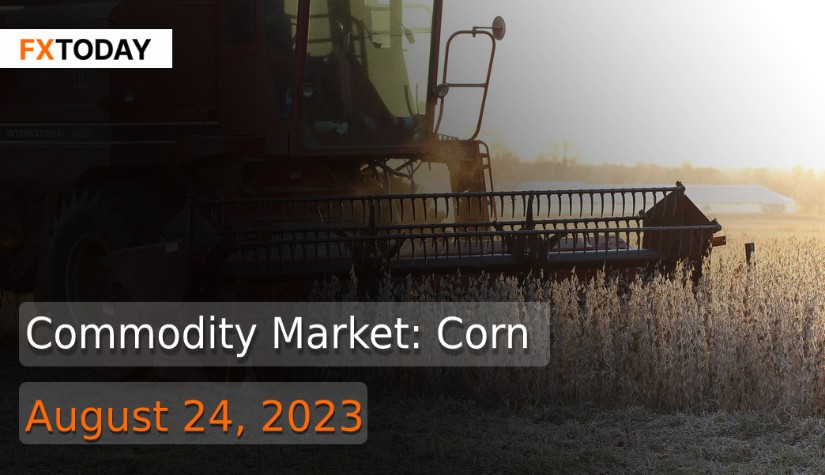Corn Market Anticipates Continued Pressure Amidst Unfolding Challenges
The recent corn market trends have been influenced by short covering and technical buying, leading to an increase in corn prices. This bounce can be attributed to several factors, including favorable weather conditions and the competitive nature of U.S. corn for export purposes. Despite competition from countries like Brazil and Ukraine, the positive margins in ethanol production are offsetting some of the negative sentiment. Ethanol production dropped from the previous week but rose significantly compared to last year. Decreased ethanol stocks also supported market improvement.
Looking at the 2023/24 U.S. corn outlook, there are projections of reduced supplies, lower domestic use, decreased exports, and tighter ending stocks. This outlook is based on various factors, including adjustments in corn use for exports, glucose, dextrose, and starch. The report suggests a decrease in corn use for feed and residual purposes due to a smaller crop.
As for foreign coarse grain outlook for the same period, there's an expectation of lower production, reduced trade, and smaller ending stocks compared to the previous month. Corn production has decreased in the EU, China, and Russia, but Ukraine and Canada have seen increases. Factor such as excessive wetness, is affecting corn yields in different regions.
The August Crop Production report by the US Department of Agriculture (USDA) indicated lowered predictions for corn production compared to July. The report's impact on the market was relatively muted, with analysts noting that challenging spring conditions have improved for fall row crops due to favorable weather and reduced impact from the Ukraine conflict.
The USDA's initial survey-based outlook projected a 10% increase in US 2023 corn production compared to 2022, the second-highest on record if realized, although falling slightly short of trade expectations. Despite Mexico's plan to ban genetically modified corn by 2024, the country continues to purchase substantial amounts of U.S. corn. Nevertheless, soft domestic corn demand in the U.S., driven by reduced livestock herds and ample ending stocks, is expected to keep prices under pressure.
Brazil's corn exports are gaining attention as the export deficit narrows. Notably, Brazil has significantly increased its corn exports in the initial weeks of August, hinting at potential growth in their corn market. However, Brazil's substantial corn production is affecting U.S. export business, with a projected 16% rise in their 2022-23 corn production. While previous export levels might be challenging to replicate, signs indicate improved export prospects.
Meanwhile, India's decision to ban sugar exports due to low-yield cane crops caused by insufficient rain adds to a list of crops, including corn, that has been adversely affected by extreme weather conditions, contributing to a challenging agricultural landscape.
Global trade dynamics are in flux, with countries like South Korea purchasing significant quantities of animal feed corn from international markets. This interest is partly driven by positive crop inspection reports from the U.S. that boosted confidence in corn conditions.
The geopolitical situation in the Black Sea region, particularly the ongoing tension between Ukraine and Russia, is impacting shipping lanes and potentially affecting corn exports. Market participants are closely monitoring this situation for potential implications on corn trade.
Recent corn futures trading shows modest gains after a previous drop, with factors like crop damage due to heat and dryness influencing market sentiment. The rise in the U.S. dollar index has put pressure on commodity traders, potentially affecting export demand.
The overall lowered corn futures prices have been influenced by a better-than-expected US corn crop, stiff competition from a record-breaking Brazilian corn harvest, and global economic concerns, resulting in the lowest prices since December 2020. The December corn future price experienced a 24% drop in a little over a month from June 21 to August 15, and experts anticipate further easing as the current marketing year concludes.
Data for Technical Analysis (5H) CFD US Corn Futures - Dec 23 (ZCZ3)
Resistance : 494.08, 495.09, 496.71
Support : 490.84, 489.83, 488.21
5H Outlook
Source: Investing.com
Buy/Long 1 If the support at the price range 489.34 - 490.84 is touched, but the support at 490.84 cannot be broken, the TP may be set around 494.67 and the SL around 488.85, or up to the risk appetite.
Buy/Long 2 If the resistance can be broken at the price range of 494.08 - 496.58, TP may be set around 498.00 and SL around 490.34, or up to the risk appetite.
Sell/Short 1 If the resistance at the price range 494.08 - 496.58 is touched, but the resistance at 494.08 cannot be broken, the TP may be set around 490.42 and the SL around 497.08, or up to the risk appetite.
Sell/Short 2 If the support can be broken at the price range of 489.34 - 490.84, TP may be set around 487.00 and SL around 494.58, or up to the risk appetite.
Pivot Points Aug 24, 2023 03:01AM GMT
| Name | S3 | S2 | S1 | Pivot Points | R1 | R2 | R3 |
|---|---|---|---|---|---|---|---|
| Classic | 486.17 | 488.21 | 490.42 | 492.46 | 494.67 | 496.71 | 498.92 |
| Fibonacci | 488.21 | 489.83 | 490.84 | 492.46 | 494.08 | 495.09 | 496.71 |
| Camarilla | 491.45 | 491.84 | 492.23 | 492.46 | 493.01 | 493.40 | 493.79 |
| Woodie's | 486.25 | 488.25 | 490.50 | 492.50 | 494.75 | 496.75 | 499.00 |
| DeMark's | - | - | 491.43 | 492.97 | 495.68 | - | - |
Sources: Brownfield Ag News, Hellenic Shipping News
Maximize your knowledge: Blog
















